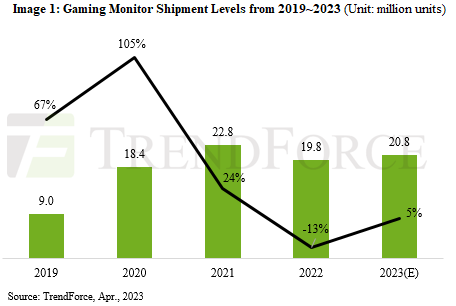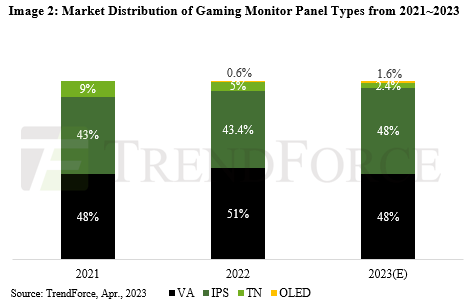Gaming Monitor Demand Fell in 2022, but Analysts Predict Quick Rebound
Inflation came for high refresh rates displays, but esports could bring them back.
Last year, gaming monitor shipments declined for the first time since 2016, according to research from TrendForce. The analysis firm suggests that "high inflation" led to 19.8 million gaming monitors being shipped last year, a 13% decline year-over-year. But the same research indicates that the rebound may be swift, with 20.8 million units shipping this year (a 5% year-over-year increase). According to TrendForce, VA monitors made up the majority of the gaming monitor market last year, coming in at 51%. IPS displays followed at 43.4%, and TV screens at 5%. OLED monitors, while becoming increasingly more popular, made up 0.6% of shipments in 2022.

Of those monitors, screens with 165 - 180 Hz refresh rates led the market at 51.9%, with 120 - 160 Hz screens at 32.5%, 100 Hz at 3.9% and 200 Hz and faster at 11.7%.
The potential rebound, the analysts believe, has three components. Firstly, several brands are taking their slowest 75 Hz panels and bumping them up to 100 Hz, marking a reason for budget monitor owners to upgrade. Additionally, China lifting Covid restrictions could mean Internet cafes will see reasons to buy more displays. Lastly, the 2023 Hangzhou Asian Games will add esports as a competing category, which might drive sales of displays for aspiring competitors.

TrendForce estimates that in 2023, OLED monitors will see a significant bump to 1.6% of the market due to "the diversification of... products" and that IPS monitors will be more competitive with VA screens due to price drops. It also expects that 100 Hz monitors will "mostly replace" 75 Hz monitors on the low-end, while the share of 120 - 160 Hz monitors will be brought into 165 - 180 Hz panels, as they already see little price difference.
In our guide to the best gaming monitors, we suggest that OLED is the best for image quality (but more expensive), followed by VA monitors with excellent contrast, then IPS displays with slightly slower response times but better color than VA. TN are the cheapest and often the fastest, but with poor viewing angles. For refresh rates, the fastest you can get is typically the best, especially for esports. But, of course, these predictions are strictly for gaming monitors, not your typical office or productivity monitor. So we'll see if 100 Hz panels at the low-end roll over to non-gaming screens in the future.
Get Tom's Hardware's best news and in-depth reviews, straight to your inbox.

Andrew E. Freedman is a senior editor at Tom's Hardware focusing on laptops, desktops and gaming. He also keeps up with the latest news. A lover of all things gaming and tech, his previous work has shown up in Tom's Guide, Laptop Mag, Kotaku, PCMag and Complex, among others. Follow him on Threads @FreedmanAE and BlueSky @andrewfreedman.net. You can send him tips on Signal: andrewfreedman.01
-
InvalidError Of course... because nobody who upgraded their systems out of cycle during COVID upgraded their monitor(s) along the way.Reply
I'm still using my 10 years old 24" 1200p Dell UltraSharp as my primary monitor, still got no plan to replace it unless it croaks or OLED becomes available in a 27" 1440p120+ format under $300. -
MiniITXEconomy Sure, I can make a prediction like that, too. If the Samsung Odyssey starts selling for $250-350, you'll see a huge resurgence! 🙄Reply
But as it stands, I'm not paying $1,200 for it or $2,000 for a flexible OLED panel (Xeneon Flex), man, come on... -
TCOMC Not sure if others have the same mind set. I'd need to upgrade my video card first before upgrading my monitor. And if video cards are priced as they are then getting a new monitor is way down the line. I can keep living with 1080 @ 144 HzReply -
bit_user I've been trying to buy a monitor for the past 2 years or so. Finally, there are models that look promising specs-wise, but they're new models and thus haven't received the same kind of price cuts as older monitors.Reply
One that's caught my interest is the ASUS ROG Strix XG27AQMR:
https://rog.asus.com/monitors/27-to-31-5-inches/rog-strix-xg27aqmr/
For me, the main downside is really just the price ($650), which is a lot for a 27" monitor without array backlighting. I don't actually want that feature, FWIW. -
bit_user Reply
I'd spend a lot more on OLED, but only if I had reason to believe I might get 10 years out of it. AFAIK, the burn-in problems haven't been conclusively solved. I'd probably go up to $1k, but anything costing so much better last a minimum of 5 years.InvalidError said:still got no plan to replace it unless it croaks or OLED becomes available in a 27" 1440p120+ format under $300.
That aside, it's a little ironic that I'm in the market for a LCD when OLEDs are finally on the market, because I've waited literally decades to buy an OLED monitor. I think I'll be waiting a bit longer... -
ReplyInvalidError said:Of course... because nobody who upgraded their systems out of cycle during COVID upgraded their monitor(s) along the way.
I'm still using my 10 years old 24" 1200p Dell UltraSharp as my primary monitor, still got no plan to replace it unless it croaks or OLED becomes available in a 27" 1440p120+ format under $300.
I'm perfectly happy with my LG CX 48" display... 4K 60 is great for the gaming I do.
bit_user said:I'd spend a lot more on OLED, but only if I had reason to believe I might get 10 years out of it. AFAIK, the burn-in problems haven't been conclusively solved.
The burn-in problems are grossly overstated. I'm not saying it can't happen... like if you leave your display on the windows taskbar for 100 hours straight at peak brightness or something... but even that is unlikely. Most OLEDs today have pixel shifting... and I personally have a 77" CX in my home theater... a 65" C1 in my bedroom... a 65" C1 in the other bedroom... and a 48" CX on my PC... all have thousands of hours on them and none have burn in of any kind. My first was a 65" B7 in 2017 that I sold with over 6000 hours on it... and yep... no burn in.
OLED is the best display IMO. Picture quality is unmatched. -
InvalidError Reply
As is the price tag :)TravisPNW said:Picture quality is unmatched.
A blue-LED array with R/G phosphor/qdots could probably beat OLED in most aspects. The reason we don't have those is probably because LEDs cannot be manufactured across a large surface with the degree of uniformity and repeatability required for a monitor or TV. -
ReplyInvalidError said:As is the price tag :)
A blue-LED array with R/G phosphor/qdots could probably beat OLED in most aspects. The reason we don't have those is probably because LEDs cannot be manufactured across a large surface with the degree of uniformity and repeatability required for a monitor or TV.
You‘re not wrong. OLED prices have come down a lot though… and I don’t expect it to be the best forever.